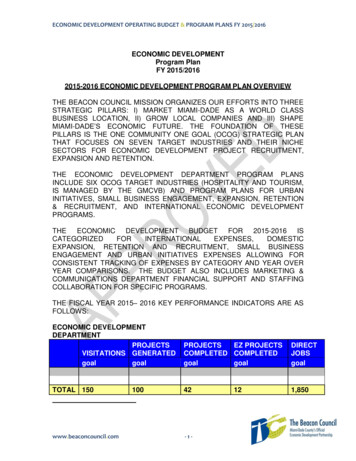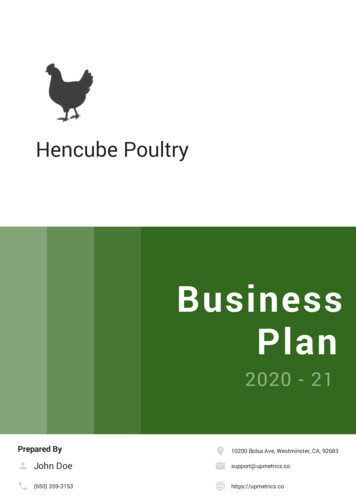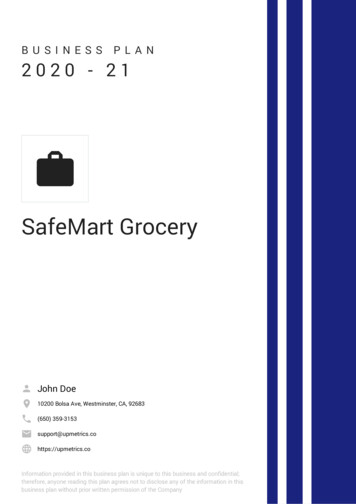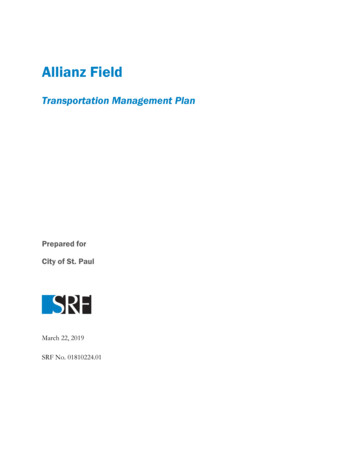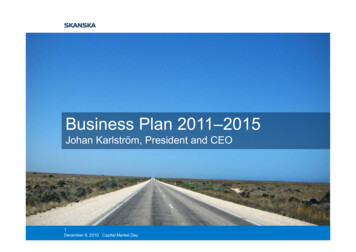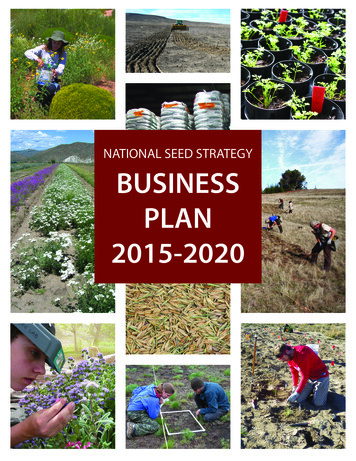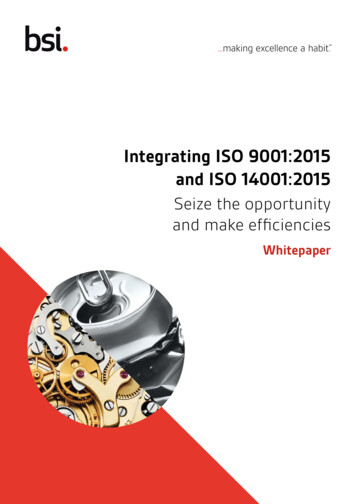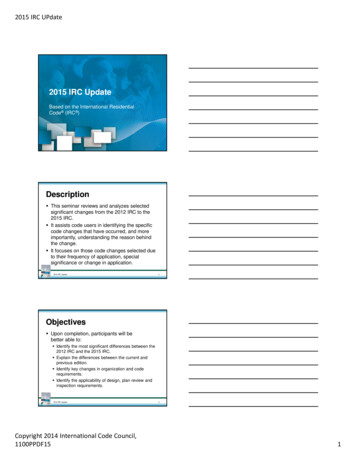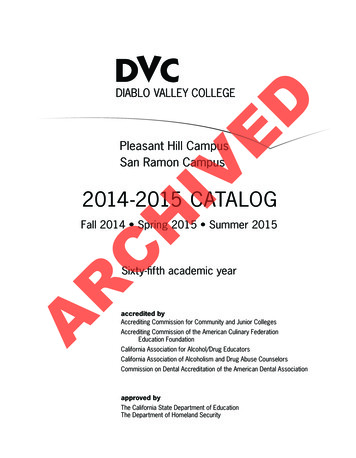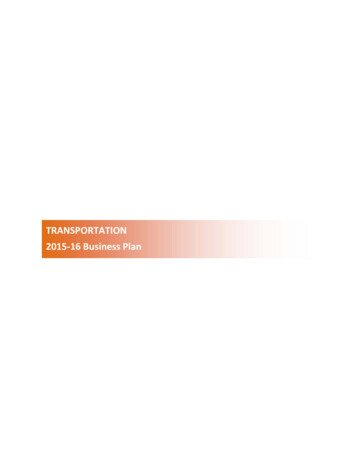
Transcription
TRANSPORTATION2015‐16 Business Plan
1. DEPARTMENTAL OVERVIEWMISSIONThe Department of Transportation’s mission is to provide for the safe, secure, accessible, andreliable movement of people and goods to serve the social and economic needs and aspirationsof the people of the Northwest Territories.GOALS1. The NWT transportation system continues to improve.2. The NWT has an ongoing high level of Northern business and employment opportunities inthe public and private transportation sectors.3. The NWT has a safe and secure transportation system in all modes.4. The department has a high performance workplace that is adaptable, effective, efficient,and innovative in delivering programs and services.5. The department will continue to ensure that the high quality of the NWT environment ismaintained.6. The department supports local transportation infrastructure.OPERATING ENVIRONMENTFocusing InvestmentsDemand from industry and the public is increasing for new roads, improved all weather andwinter roads, and airport runway extensions to support development, inter‐community travel,and a reduced cost of living in communities across the NWT. In recent years, the federalgovernment allocated a large amount of infrastructure funding under various programsincluding the Canadian Strategic Investment Fund and the Building Canada Plan. The GNWTalso invested in transportation infrastructure through the Reducing the Cost of Living StrategicInitiative. As these programs sunset, the department must explore new partnershipopportunities and financing alternatives for capital project delivery. The federal government’snew Building Canada Plan presents an opportunity to continue ongoing system wideimprovements.Sustaining an Under‐Developed and Aging Transportation SystemThe department is challenged by the need to upgrade substandard transportationinfrastructure and to rehabilitate and replace aging infrastructure with limited resources. Muchof the existing NWT infrastructure was built to the standards that are no longer current andnow require extensive investments to maintain operability and reliability. Major culverts,bridge structures, airfield lighting systems and maintenance and air terminal buildings arereaching the end of their lifecycles and must be rehabilitated or replaced. Investments are alsorequired to replace chipsealed sections of highways and airport surfaces that have reached theend of their service lives. Chipsealed surfaces that are not resurfaced must be returned togravel to maintain safety. The department is working to ensure an appropriate level ofinvestment is directed to upgrading and rehabilitating the transportation system andmaintaining existing assets.2015‐16 Annual Business PlanPage 2
Expanding the System to Connect Communities and Enable DevelopmentExpansion of the NWT transportation system will facilitate economic diversification andimprove the quality of life for residents who will gain increased access to essential services,economic opportunities, mobility, and a reduced cost of living. The NWT’s vast mineralpotential alone is consistently ranked by mining companies surveyed by the Fraser Institute asone of the highest in North America, yet the NWT continues to have insufficient infrastructurerequired to achieve its full potential. With the GNWT now receiving resource revenuesfollowing devolution, pressure will increase from industry to expand the system, strengthenintermodal capabilities and develop serviced land at airports to unlock that potential. TheGNWT is examining processes to make sound investment decisions related to investments topromote development.Accommodating Increasing Regulatory RequirementsThe department is subject to increasing regulatory requirements aimed at protecting theenvironment and ensuring public safety within the transportation system. In addition toterritorial standards, the department must comply with federal transportation safety, security,and environmental regulations. These regulations add increased monitoring and reportingresponsibilities to staff workloads, driving the need for additional resources to meet requiredefforts. With large capital projects underway, such as the Inuvik to Tuktoyaktuk Highway, thestructure of the department has re‐organized to accommodate the human resources requiredto ensure ongoing regulatory compliance and reporting. . Similarly, new approaches toregulatory compliance have resulted in organizational and cultural changes within theDepartment with a focus on continuous improvement.Adapting to Climate ChangeOver the past 20 years, the trend to warmer than normal temperatures has delayed theopening of ice bridges, reduced the operating window of the winter road system, increasedO&M costs, increased the use of consumables such as sand, salt, and runway chemicals, and hasled to increased variability and unreliability within the transportation system. Permafrostdegradation increases O&M costs and accelerates the need for capital rehabilitation. Pressureis increasing to adapt to the effects of climate change by improving surface and drainageconditions on highways and airport runways, realigning winter roads to overland right‐of‐ways,building permanent bridges to extend and stabilize the winter road seasons and investing innew visual and navigational aids and technologies at airports. The department has completed aclimate change adaptation plan and continues to advance research and development toimprove our operations and construction techniques.Addressing Human Resource PressuresA healthy, productive, and sustainable workforce is essential to meet the department goals andobjectives. Age‐related attrition is a significant challenge for the department with 43 percent ofthe current workforce over the age of fifty. Twenty‐nine percent of the department staff iseligible to change due to age‐related attrition within the next four years. This is especiallycritical when examining the workforce by the type of position. Between 38 and 45 percent ofmiddle and senior managers, engineers, technologists, and service personnel are eligible to2015‐16 Annual Business PlanPage 3
retire within the next ten years. The department has taken advantage of GNWT AboriginalManagers Program, Leadership Development Training, Transfer Assignments and AssociateDirector/Manager Program to help address human resource succession planning and attractand retain staff.2015‐16 Annual Business PlanPage 4
2. RESOURCE SUMMARYDepartmental Summary(thousands of sOperations Expenses by ActivityCorporate ServicesMarineHighwaysAirportsRoad Licensing & SafetyCommunity Access ProgramTotal Operations Expenses by 51037,538Operations Expenses by ObjectCompensation and benefitsGrants and ContributionsOtherAmortizationTotal Operations Expenses by ObjectRevenuesHuman Resources SummaryProposed2015‐16MainEstimatesYellowknife HeadquartersRegional / Area OfficesOther CommunitiesTotal Number of Positions2015‐16 Annual Business 9298302Page 5
KEY ACTIVITY 1 – CORPORATE AND MANAGEMENT SERVICESDescriptionThe Corporate Services key activity is comprised of the Directorate; Planning, Policy, &Communications; Environmental Affairs, and Corporate Services divisions.Under the guidance of the Deputy Minister, the Directorate and divisions under this activityprovide leadership, planning, and overall management of the department and providesstrategic advice and support to the department and Minister.The Planning, Policy, and Communications division provides services related to strategicbusiness and capital planning, transportation planning, ministerial briefings and support,decision instruments, policy and legislative initiatives, and regulations. The division is also isresponsible for the department’s communication projects, strategies, and public relations.The Environmental Affairs division is responsible to monitor regulatory compliance, mitigatethe environmental impact of department operations, and lead the department throughenvironmental assessments and regulatory processes for major capital projects.The Corporate Services division provides department‐wide advice and support in financialservices, contracts services, information systems, occupational health and safety, recordsmanagement and Access to Information and Privacy requests. The division also supports arange of DOT human resource initiatives.Responding to Goals and Priorities of the 17th Legislative AssemblyPRIORITY 1 – BUILDING A STRONG AND SUSTAINABLE FUTURE FOR OUR TERRITORY1. DescriptionStrengthening our relationships with Aboriginal and other Northern governmentsMajor Program and Service Initiatives Planned for 2015‐16The Department of Transportation continues to collaborate with community and Aboriginalgovernments to improve the transportation system. For example: Subject to available federal and GNWT funding, the department will collaborate withAboriginal land claim organizations to advance the Wrigley to Norman Wells segment of theMackenzie Valley Highway project through the environmental assessment. DOT is alsoworking with the Gwich’in Tribal Council to collect additional baseline information on thefuture road from Fort Good Hope to the Dempster Highway. DOT and the Tłįchǫ government are collaborating on work relating to a Project DescriptionReport to construct a proposed all‐weather road to Whatì DOT is working to add the 160 km winter road to Wekweètì to the NWT public highwaysystem in response to a Tłįchǫ̨ government request2015‐16 Annual Business PlanPage 6
2. DescriptionWorking with our partners to ensure responsible stewardship through our land and resourcemanagement regimeMajor Program and Service Initiatives Planned for 2015‐16DOT will continue implementing actions under the departmental strategy, Green Light:Signaling the Department of Transportation’s Commitment to the Environment and willcontinue to implement related actions, such as: Develop a Green House Gas Reduction Plan to improve energy efficiency and conservationinitiatives Continue the remediation of hazardous sites and environmental liabilities, such as the JamesCreek Highway Maintenance camp on the Dempster Highway Develop an Environmental Management SystemPRIORITY 3 – STRENGTHEN AND DIVERSIFY OUR ECONOMY1. DescriptionMaking strategic infrastructure investments such as the Inuvik Tuktoyaktuk Highway, theMackenzie Valley Fiber Optic Link, and hydro initiativesMajor Program and Service Initiatives Planned for 2015‐16 A common corridor between the proposed Mackenzie Valley Highway and the Fiber Opticinitiative provides an opportunity to partner on information requirements for anenvironmental assessment Construction of the Inuvik Tuktoyaktuk Highway will resume in October 2014 providing jobsand training opportunities for Beaufort Delta residents and prospects for research anddevelopment initiatives managing permafrost.Departmental HighlightsNew Building Canada PlanThe federal government’s new Building Canada Plan represents significant opportunities for theGNWT to advance economic development and well‐being for NWT residents. The Provincial‐Territorial component of the plan presents opportunities to invest in core transportationinfrastructure leading to economic growth, job creation, increased productivity, and enhancethe quality of life in communities all across the NWT. DOT is working with other GNWTinfrastructure departments and the federal government to obtain additional program detailsrequired to make strategic investments in transportation infrastructure under the new BuildingCanada Plan.Infrastructure Funding PartnershipsFunding will be pursued through various federal programs such as the Airport Capital AssistanceProgram, the federal Department of National Defense for capital needs at the Inuvik Airport,2015‐16 Annual Business PlanPage 7
and Parks Canada for capital needs in Wood Buffalo National Park. As opportunities arise, thedepartment will seek partnerships with industry for improved services on the Mackenzie ValleyWinter Road to support developments. Partnership opportunities with CanNor will be pursuedto advance the environmental review process relating to the southern section of the MackenzieValley Highway.NWT Multimodal Transportation StrategyWork is underway to renew the transportation strategy to ensure system needs are evaluated,prioritized, and well documented in a comprehensive, multi‐modal transportation strategy. Thestrategy is being developed with input and engagement with a wide range of stakeholders,including NWT residents, Aboriginal and community governments, MLAs, transportation, aircarriers, and industry.Adapting to Climate ChangeThe Department will continue to implement recommendations made in the Climate ChangeAdaptation Plan and continue to undertake research into potential implications climate changemay have on the transportation system including vulnerability assessments of systemcomponents built on permafrost. The department will collaborate with researchers, experts,other jurisdictions, and the Transportation Association of Canada (TAC) to continue leading andparticipating in the Network of Expertise on Permafrost and Arctic Waters.Asset Management SystemInnovative management systems are necessary to prioritize limited resources and monitor thelife cycle of assets, programs and operational and maintenance activities. The department willcontinue to review, improve, and implement asset management systems to manage themaintenance, repair, and life cycles
2015‐16 Annual Business Plan Page 7 2. Description Working with our partners to ensure responsible stewardship through our land and resource management regime Major Program and Service Initiatives Planned for 2015‐16 DOT will continue implementing actions
